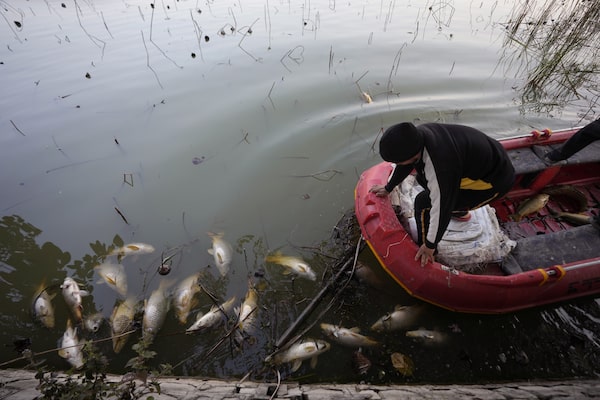
A wildlife worker removes dead fish from the Mansar Lake, east of Jammu, India, on Feb. 9.Channi Anand/The Associated Press
Hundreds of wildlife species whose life cycles involve movement across geographic boundaries are in serious decline around the world, according to a new United Nations report.
In the first such assessment of its kind, authors of the report, released Monday, found that more than one-fifth of species listed under the UN Convention on the Conservation of Migratory Species of Wild Animals are at risk of extinction.
An additional 399 species that are not listed under the treaty were also found to be at a similar risk level.
The species encompass birds, fish and terrestrial animals, many of which must travel long distances, often across international borders, a fact that only complicates efforts to improve their prospects for survival.
“It’s very important that we understand the status of those species, the challenges they face and the solutions for their conservation,” said Amy Fraenkel, the convention’s executive secretary, during a news briefing.
She added that species’ shrinking numbers are largely driven by human activities, particularly over-exploitation of wildlife species and habitat loss or degradation.
Other threats include pollution and, increasingly, climate change, which can interfere with the appearance and timing of food resources that migrating species require to sustain them in their long-distance travels.
“When you dig into it, you find that a lot of the bad news is actually being driven by freshwater and marine fish,” said John Reynolds, a conservation biologist and professor at Simon Fraser University in British Columbia who was not involved in the report.
In total, the report found that 97 per cent of migratory fish species under the convention are now considered to be globally threatened, including 176 populations representing 37 different species.
While some fish species are targeted intentionally for harvesting, others may be swept up as bycatch or otherwise affected by industrial-scale fishing operations.
“I think many people should be really sitting up and taking notice,” Prof. Reynolds said, adding that that report’s authors include an “A-team” list of experts in global conservation.
The report also found that three-quarters of the species listed in the convention have been negatively affected by habitat loss.
To shed further light on this issue, the authors examined the status of critical habitat needed by migrating species, which conservation biologists refer to as “key biodiversity areas.” They found that only about half of such areas enjoy protected status and that most of those that are protected still face unsustainable levels of pressure from various human activities.
Also worrying is the fact that “there are many species that that don’t have any key biodiversity areas identified for them,” said Kelly Malsch, head of the UN Environment Programme World Conservation Monitoring Centre and lead author of the report.
She added that a full and effective implementation of the convention would help to combat threats that species face and arrest their downward trajectory.
One way to do so would be for members to follow through on the Montreal-Kunming global biodiversity framework, which was signed by 196 countries, including Canada, in December, 2022, and which included protecting 30 per cent of land area as well as fresh and marine waters by 2030.
“We know what actions need to be taken,” Ms. Malsh said. “The conservation of migratory species and their future is in our hands.”
 Ivan Semeniuk
Ivan Semeniuk